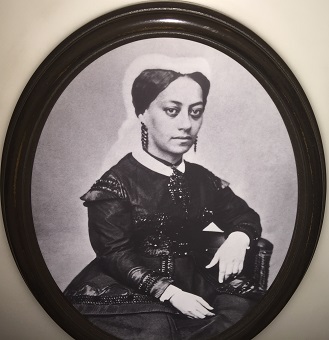Mary Ellen Pleasant was called many things in her
lifetime: Slave, Abolitionist, Cook, Madame, Entrepreneur, Real Estate Mogul, White
woman and “Mammy.” She described herself in the 1890 census as “a capitalist by
profession.” By her autobiography of 1902, she claimed her mother was a
Louisiana Negress and her father a native Hawaiian. In some accounts, she said
her mother was a Voodoo princess and her white father was John Pleasants, the
son of the VA governor. The date of her birth ranges from August 19, 1812-17
with most writers settling on 1814. She died on January 4, 1904, poor and
befriended by the Sherwood family in whose Napa plot she was buried.

Sometime between age 6 and 13, Mary Ellen was sent to
Nantucket, RI as an indentured servant to “Grandma” Hussey. She worked off her
time, growing very close to Mrs. Hussey, a Quaker shop owner, learning of and
participating in the Underground Railroad and the cause of Abolition. An avid
reader, she educated herself in many disciplines and became adept at figures.
Mary Ellen met and married wealthy John James Smith, a
plantation owner who had freed his slaves and passed as white. They worked
together on the Underground Railroad in different states and Canada until his
death four years later. He left her money and instructions to continue their
work.
Around 1848, Mary Ellen formed a partnership with John
James (JJ) Pleasants and may have married but no record exists. They had a
child: Lizzie J. Smith who was left with friends or family at some point. Lizzie
came west, married and died in her twenties. Her relationship with MEP is
unknown.
The Pleasants continued with Smith’s work in the NE,
attracting too much attention from slavers. They fled to New Orleans where JJ
was a relative of Voodoo Queen Marie LaVeau’s husband. The two women drew close
in the four years MEP was there. By 1852, JJ preceded his wife to San Francisco;
she soon traveled by boat, passing as white. JJ Pleasant was a well-paid ship’s cook and Mary Ellen
was a live-in domestic at first. They shared joint residency from time to time
and continued their abolitionist work.
As Mary Ellen Smith, she soon had a catering business that
thrived by serving rich white men. She absorbed investment information and the
tricks of wheeling and dealing in the riches of the gold mining era. All it
took was listening and evaluating the discussions of her customers! She helped
place blacks in employment in her own ventures (laundries, boardinghouses,
catering) as well as the Palace Hotel and other white controlled businesses.
She began her affiliation with Thomas Bell, a Scottish clerk in the Bank of
California. Together they eventually had a $30 million fortune. She lived with
the Bell family at the House of Mystery in SF for many years.
Years later, Mary Ellen left San Francisco, 1857-1859, to aid John Brown with work and money. One story has it that when he was arrested after the Harper's Ferry, VA fiasco he had a letter in his pocket, signed only with her initials. She asked that a sign be placed on her grave. In 1965, the San Francisco Negro Historical and Cultural Society placed the marker: "She was a friend of John Brown."
| JOHN BROWN |
The crux of Mary Ellen’s life is her fight for human
rights, beginning in Nantucket and spreading all the way to San Francisco. From
“slave stealing” for the Underground Railroad to court cases, she led the way.
MEP first entered the legal system soon after arriving
in San Francisco when she supported the case of George Mitchell, brought to CA
by his owner in 1849; the owner wanted to return East, taking Mr. Mitchell
also. The judge determined that the act to remove had ended and the case continued
with evasive delays until 1855 when the CA Fugitive Slave Act expired and the
case resolved. In 1852, MEP was a founding member of the Franchise League which
sought to allow blacks to testify in court. A busy first year in the City!
The years before, during and after the Civil War were
very busy for the Pleasants as their influence and riches increased. The 1860’s
saw her in court fighting for people of color to be free to travel by public transportation. She won in several instances. Other cases hinged on women's rights..
BELTANE RANCH
Mary Ellen invested in
many properties over the years; she was alleged to own eight or more houses in
San Francisco and a ranch near San Mateo. In 1890, she bought an established a ranch
in the Valley of the Moon (Sonoma County,) designed the ranch house with its New Orleans influence, She spent many weekends there in her last years. She named it “Beltane Ranch" for Thomas Bell his Celtic heritage...Beltane is a fertility festival held in early May.
It is impossible to do a complete review of this woman’s amazing life and
accomplishments here. Books, fiction and non-fiction, movies and news articles
have attempted to portray Mary Ellen’s life. Many are in error or complicated
due to lack of reliable information and the very complexity of her life.
References:
1. Beltaneranch.com,
website for the historic ranch
2. Fowler,
Karen Joy, Sister Noon, a novel, George
Putnam’s Sons, 2002
3. Hudson,
Lynn M., The Making of “Mammy Pleasant,” University
of Illinois Press, 2003
4. Wikipedia,
Mary Ellen Pleasant

Correction: Mary Ellen Pleasant bought what became Beltane
ReplyDeleteRanch in 1892.
What a fascinating post, Arletta. Sad to think she once had ten million yet died penniless. Obviously, she made a positive difference in many lives.
ReplyDeletereplica gucci shoes, combining elegant style and cutting-edge technology, a variety of styles of replica gucci high-top shoes, the pointer walks between your exclusive taste style.
ReplyDelete